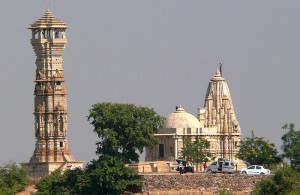Tourist Attraction of Chittorgarh
When we talk about Rajasthan, Chittorgarh is the most romantic city. It is also called Chittaur, Chittor, Chittorgarh or Chittaurgarh sometimes also called the fort city of rajasthan. Bappa Rawal founded Chittorgar in the 8th century. Chittorgarh is the epitome of Chattari Rajput (an Indian Warrior caste) pride, romance and spirit, for people of Chittor always chose death before surrendering against anyone. It reverberates with history of heroism and sacrifice that is evident from the tales still sung by the bards of Rajasthan. Though it can now be called a ruined citadel there is much more to this huge fort. It is a symbol of all that was brave, true and noble in the glorious Rajput tradition. The weather in Chittorgarh is always very pleasent. During the winter season temperature is about 12 degree Celsius and 24 degree Celsius in the summer. Thus the best time to visit Chittorgarh is between September to March.

Chittorgarh Fort is the largest fort in India and the grandest in the state of Rajasthan. It is very well known for the biggest fort of Rajasthan that is the reason peoples also refer it as the fort city. The Chittorgarh Fort seated on a 180 metre hill, covers an expanse of 700 acres (2.8 km2). It was constructed by the Mauryans in the 7th century AD. There is also a belief that it was constructed by Bhima of the Pancha Pandavas. This fort was the citadel of many great Rajput warriors such as Gora, Badal,Rana Kumbha, Maharana Pratap, Jaimal, Patta, etc.

The Vijay Stambha (Tower of Victory) or Jaya Stambha, called the symbol of Chittor and a particularly bold expression of triumph, was erected by Rana Kumbha between 1458 and 1468 to commemorate his victory over Mahmud Shah I Khalji, the Sultan of Malwa, in 1440 AD. Built over a period of ten years, it raises 37.2 metres (122 ft) over a 47 square feet (4.4 m2) base in nine stories accessed through a narrow circular staircase of 157 steps (the interior is also carved) up to the 8th floor, from where there is good view of the plains and the new town of Chittor. The inside walls of the tower are carved with images of Gods, weapons, etc. The dome, which was a later addition, was damaged by lightning and repaired during the 19th century. The Stamba is now illuminated during the evenings and gives a beautiful view of Chittor from the top.

Kirti Stambh (Tower of Fame) is dedicated to Rishabha, the first Tirthankara of Jainism. It was built by a merchant and is decorated with figures form the Jain pantheon.It is a seven storied pillar which was build by Biherwal Mahajan Sanaya of Digambar Jain sect during 12th century AD. On its four corners are engraved idols of Shri Adinathji in Digambar style which each are five feet (about 1.5meters) high and elsewhere are engraved several small idols consecrated to Jain lineage of deities.

Rana Kumbha's Palace is near the Vijay Stambh. This is the birthplace of Maharana Udai Singh, the founder of Udaipur. His life was saved by the heroic act of the maid Panna Dhay, who replaced her son in place of the prince, with the result that her son was killed by Banbir. She carried the prince away to safety in a fruit basket. Rani Meera Bai also lived in this palace. This is the place where Rani Padmini committed jauhar with the other ladies in one of the underground cellars.
Rani Padmini's Palace
Rani Padmini's Palace is from which Alauddin Khilji (one of the rulers of Khilji dynasty during the sultanate rule over India) was allowed to watch a reflection of the Rani by replacing the mirror at such an angle that even if he turned back he could not see the room. Khilji had been warned by the Rani's husband Rawal Ratan Singh that if he turned back they would cut his neck.
Kalika Mata Temple
Kalika Mata Temple was originally built in the 8th century for Sun God and was later converted to a temple for mother Goddess, Kali in the 14th century.During the festival days of Navaratri, fairs are organised and pilgrims from different places come here to pay obeisance at the temple.

Two massive temples also lie within the fort. One was built by Rana Kumbha and the other by Mira Bai, the saint-poetess and Krishna’s devotee. The masonry for these temples was brought from the ruins of ancient shrines near Chittor. Rana Kumbha’s Vrij temple (1450AD) is dedicated to Varah, the god with the body of a man and the head of a boar. Near these temples are two kunds or reservoirs, each measuring 125 feet in length, 50 feet across and 50 feet deep. However, they were not meant to store water and were constructed for the wedding of a Chittor princess to a prince of Gagron. They were filled with oil and ghee (clarified butter) which was served out to attendants and guests. Near Mirabai’s temple is the cenotaph of Mirabai’s guru Shri Rai Das. Inside the cenotaph is a statue depicting five human bodies fused together with one head, signifying that there are no caste differences and even outcasts can reach out to god.


